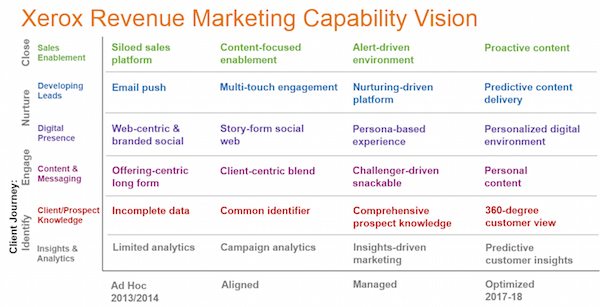Disruptive innovation can be exhausting. Exciting. Full of opportunity. But also relentless hard work. And with all the disruptive innovation wrought by the Internet — particularly the seismic changes in marketing — there are times when even the best of us could use a little boost of inspiration.
Today’s marketing technologist interview was just that boost of inspiration for me because it features a 113-year old company — Thomas Publishing Company — which has adapted itself into this new digital century. And, hey. If a company with that much legacy can change, the rest of us have hope!
Brian Makas is the Director of Marketing Technology & Business Intelligence at Thomas’s new incarnation, ThomasNet.com. He’s had the opportunity to participate in their transformation at this nexus of marketing and technology. Here he offers us some of his perspective on that process, what his role looks like today, and more.
Brian Makas, Director, Marketing Technology & Business Intelligence, ThomasNet.com
Thomas Publishing Company was founded in 1898, right? What has it been like implementing digital strategy at a firm with such long history?
That’s correct. Thomas Publishing Company was founded in 1898 when it started publishing the Thomas Register. For more than 100 years, the Thomas Register was the foremost directory of the industrial marketplace. That said, when I came on board in 2006, Thomas made the decision to stop publishing the print directory in favor of ThomasNet.com.
When ThomasNet first went online, it still listed the same 650,000 distributors, manufacturers and service companies within 67,000+ industrial categories… but… that was about it. It didn’t take long before we realized that for our clients to be truly successful, we also needed to help them deliver the detailed content that engineers and purchasing managers want. And we needed to give clients a way to track their efforts and correlate that to their success.
So, I’m fortunate enough to have the best of both worlds. While I have access to over 100 years of industrial expertise, ThomasNet itself still has a fresh entrepreneurial spirit — in how we enable our clients’ marketing departments to succeed and in which we, ourselves, engage in digital marketing.
Can you share with us a little bit about how your team is structured and the type of projects you’re working?
To describe my job, can I just go ahead and check off every box in your 8 Things a Marketing Technologist Should Know post? In this last week alone I’ve been worked on optimizing landing pages, tweaking our social and search engine marketing initiatives, streamlining our CRM system, upgrading our marketing automation platform, providing our clients with more sophisticated means of tracking their return on investment and, finally, connecting a half dozen or so once-distinct data silos.
Although I get knee deep in code when it’s absolutely necessary, cloud technology makes it possible for me to leave ownership of the technology where it belongs: with the subject matter experts rather than with a team of technical experts.
“Cloud technology makes it possible for me to leave ownership of the technology where it belongs: with the subject matter experts.”
How does your marketing technology team fit into the larger marketing organization? What’s your relationship with IT?
Our IT department is responsible for the management of all physical (or “on premise”) infrastructure. The marketing department is responsible for everything else, including any applications hosted in the cloud.
While IT provides a critical service — and we have a very positive relationship — our interactions are essentially limited to times when we need new hardware or when said hardware requires servicing.
How did you arrive at your current position? Was there a turning point in your career?
I’d say there were two key turning points.
The first occurred between my sophomore and junior years of college. I went to college at Rensselaer Polytechnic Institute (RPI), majoring in computer science with the intention of becoming a programmer. But after interning at a small manufacturing firm I discovered I could have a much greater impact — solving problems that the staff didn’t even know they had — simply by walking around and listening to what they were doing. That semester, I transferred into the newly formed school of IT, with a focus in Management Information Systems. I was one of the first five graduates — getting a job within my new company’s Business Continuity Planning department, rather than in IT itself.
The second pivot occurred while working at The Wallace Foundation, where I came in as a network systems engineer. I soon heard about an upcoming website redevelopment project, and volunteered my time. This was the first time The Wallace Foundation began work on a website with IT included at the start of a project, rather than waiting for the business requirements to be defined. The timing was critical — enabling me to exceed design expectations and ensure the site met the foundation’s strategic goal of facilitating idea-sharing by increasing downloads of their research reports by over 2,000%. I quickly found myself working nearly full time for marketing.
“I quickly found myself working nearly full time for marketing.”
How do you see business intelligence evolving, both technologically and organizationally?
Having started my career in IT and having seen one too many mission critical databases built in Excel, I believe that “Shadow IT” can be a very real problem, particularly when IT is held responsible for producing a single view of an organization’s data.
On the other hand, cloud computing platforms now make it easy for marketing to develop fully scalable and standardized systems, with very little technical expertise. That’s beginning to alleviate many of IT’s concerns about rogue development as it naturally breaks down data silos and exposes data that might otherwise have been lost.
For example, we use Salesforce.com to manage our prospecting, lead nurturing, sales support, recruiting and client databases. Want to know how many times we touch the average prospect before they make their first purchase — or how support influenced their purchasing behavior? Thanks to the shared platform, we can quickly and easily cross reference the information stored in each application — in real-time and without IT support — even though the reporting need wasn’t realized until well after the applications were built.
“We can quickly and easily cross reference the information stored in each application — in real-time and without IT support.”
If you could give 30 seconds of wisdom on marketing technology to the CMO of a Fortune 500 company, what would you say?
To fully quantify your marketing efforts, make sure the data is pulled together by a team that understands both the technical nuances and “gotchas” of data collection as well as the aims of the marketing department. And, as hard as it is to say in today’s data-driven environment, sometimes you still just have to trust your gut.
Any advice you would give to new marketing technologists?
Success as a marketing technologist often comes from solving problems that others might not even be aware of. But to do that, you need to get involved early in the process.
Take the time to really understand the challenges marketing is facing — and make the effort to explain how new tools or new approaches can simplify their lives or make their efforts more successful.
“Success as a marketing technologist often comes from solving problems that others might not even be aware of.”
Thanks, Brian! You know, as an odd personal coincidence, my dad used to work with Thomas Publishing back in the 1970’s. It’s very cool to see how it’s evolved 40 years later.



